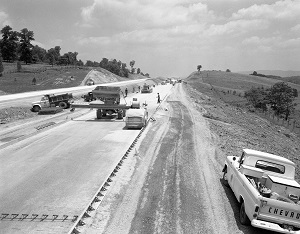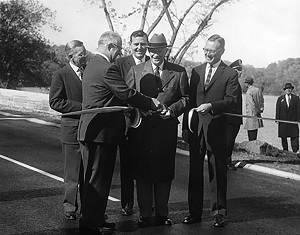

When Interstates Paved the Way
The construction of the Interstate Highway System helped to develop the U.S. economy
In 1939, the New York World's Fair offered attendees a time traveling look at the "World of Tomorrow." In the General Motors Futurama exhibit, visitors toured an enormous scale model of what a city would look like in 1960. Futurama simulated a low-flying airplane journey; the 18-minute ride gave guests a bird's-eye view of 36,000 square feet of miniatures, including more than 500,000 buildings, 1 million trees of 13 different species, and nearly 50,000 motor vehicles. Probably the most advanced technology in the diorama was the remote-controlled 14-lane multispeed interstate highway system, which introduced the general American public to the concept of a network of expressways connecting the nation. Today, there are several interstate highways in the United States that boast 14 or more lanes. But these mega highways were not built overnight; it took many years of work to receive congressional approval and decades more to construct the network that millions of Americans travel on every day. The improved mobility that the interstate highway system provides has done more than make road trips easier — it has contributed to the growth of the U.S. economy.
From Dirt to Pavement
In the early 20th century, Henry Ford and his assembly line made the Model T car affordable to working-class citizens, which increased mobility exponentially. As cars became more accessible, there was an increased need for greater funding for car-friendly roads. In the 19th century, most roads were constructed for horses and wagons out of dirt or gravel and generally used to travel short distances. To accommodate the Model T craze and meet the demand for better roads, Congress passed the Federal-Aid Road Act in 1916, which granted $75 million to states for road construction and improvement. It was the first legislation that provided federal aid to the states for their highways. But most states' road construction projects were delayed or slowed in 1917 as labor and capital were shifted to help the war effort, leaving few resources available for other projects. By the end of World War I, only five federal-aid projects had been completed, totaling just 17.6 miles of road.
Railroads were initially the primary method of shipping freight, consumer goods, and people across states. The increased number of shipments required by the war, however, caused the railroads to become congested. One solution to this problem was to ship some of the cargo on trucks. So interstate transportation of freight by truck became essential, yet interstate roads were still primarily made of dirt, and the trucks caused substantial damage to them. For example, according to the U.S. Federal Highway Administration (FHWA), roads in New York that cost $11,000 per mile to build in 1912 were estimated to cost $32,000 per mile to repair at inflated 1918 costs. Despite these costs, it soon became evident that the cost savings of shipping by truck outweighed the costs of repairing roads.
During the Great Depression, the Public Works Administration, part of President Franklin D. Roosevelt's New Deal program, advanced national road construction, created jobs, and improved the economy by building thousands of miles of roads. These roads were part of the U.S. Numbered Highway System, a paved network of two-lane roads, carrying a U.S. route number that crisscrossed the United States. One of the most famous highways constructed during this time was U.S. Route 66, a 2,448-mile stretch of road that linked Chicago to California. In addition to bringing farm workers to California from the Midwest, many Americans enjoyed driving on Route 66 simply for the sake of traveling and seeing the sights along the way.
As passenger and truck traffic on the U.S. highway system grew, however, it became apparent that these roads were beset with deficiencies of design, efficiency, location, and safety. And there was an increased interest in an upgraded interstate network. In 1939, around the time of the world's fair, Roosevelt addressed Congress with a call to action for the development of "a special system of direct interregional highways... to meet the requirements of the national defense and the needs of peacetime traffic." But following the attack on Pearl Harbor in December 1941, the United States entered World War II, and plans for a national highway system were mostly delayed.
Following World War II, the need for efficient transportation networks became a priority again as the United States emerged as a world leader in goods production. To jumpstart this process, Roosevelt signed the Federal-Aid Highway Act of 1944, authorizing a 40,000-mile national system of interstate highways. Budget legislation did not provide any funding programs for building such a system, however, so development of the interstates would have to wait.
Launching a New Program
The development of the interstate highway system as we know it today can be attributed to President Dwight D. Eisenhower. As a military officer during World War II, he was impressed by the German autobahns and wanted a similar highway system for the United States. When he became president in 1953, he revived interest in constructing a national interstate system. On June 29, 1956, Eisenhower signed the $25 billion Federal Aid-Highway Act of 1956, sanctioning a highway system (later named the Dwight D. Eisenhower System of Interstate and Defense Highways) of 41,000 miles of highways, with strict standards, including nearly 2,000 miles of already-completed toll roads, with the goal of being completed by 1975. In 1968, Congress increased the total length to 42,500 miles.
The interstate system was initially designed to serve three main purposes: to connect the principal metropolitan areas, cities, and industrial centers; to serve the national defense; and to connect at suitable border points with routes in Canada and Mexico. Eisenhower additionally stated four key principles of its construction, which remain to this day: to reduce fatalities and injuries; to keep the roads maintained and in good condition to reduce vehicle operating costs; to permit a means of quick evacuation, military mobilization, and movement of goods; and to manage congestion.
To raise money for the construction of roads on a national scale, Congress created the Highway Trust Fund, which funded 90 percent of construction costs. This fund generated revenue through federally imposed user fees on motor fuels, increasing the price of a gallon of gasoline by one cent. States would pay the remaining 10 percent. By the summer of 1957, most states had begun construction of their segments of the interstate system. Today, more than 46,700 miles of interstate highways are open to traffic. The Dwight D. Eisenhower System of Interstate and Defense Highways serves most large U.S. urban areas and 49 of the 50 states, all but Alaska.
Receive an email notification when Econ Focus is posted online.
By submitting this form you agree to the Bank's Terms & Conditions and Privacy Notice.



